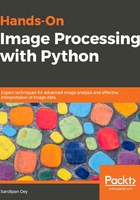
Correlation versus convolution
Correlation is very similar to the convolution operation in the sense that it also takes an input image and another kernel and traverses the kernel window through the input by computing a weighted combination of pixel neighborhood values with the kernel values and producing the output image.
The only difference is that, unlike correlation, convolution flips the kernel twice (with regards to the horizontal and vertical axis) before computing the weighted combination.
The next diagram mathematically describes the difference between correlation and convolution on an image:

The SciPy signal module's correlated2d() function can be used for correlation. Correlation is similar to convolution if the kernel is symmetric.
But if the kernel is not symmetric, in order to get the same results as with convolution2d(), before placing the kernel onto the image, one must flip it upside-down and left-to-right.
This is illustrated in the following screenshot; you can go ahead and write code for this in order to get this output now that you know the logic! Use the lena_g image as input and apply an asymmetric 3 x 3 ripple kernel ([[0,-1,√2],[1,0,-1],[-√2,1,0]]) onto it separately with correlation2d()and convolution2d():

Frame two is as follows:

Frame three is as follows:

It can be seen that the difference between the output images obtained with correlation and convolution is blank if the asymmetric kernel is flipped before applying correlation2d().
Let's move on to see an interesting application of correlation.